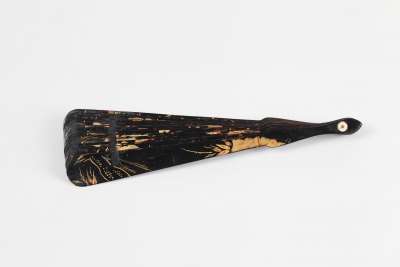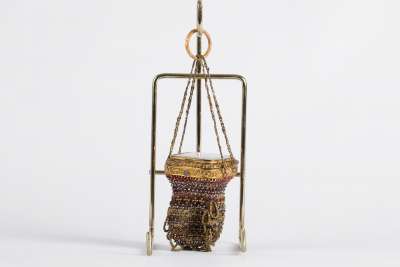The Medicine Glass & Minim Measure set is an intriguing piece of medical history, dating from the period between 1870 and 1930. This antique set includes a cylindrical glass with etched measurement scales in teaspoons and tablespoons, and a minim measure, which is a small cylindrical tube used for precise liquid measurements. Minim measures were critical for apothecaries and medical practitioners, with a minim equating to one drop of water. Originating from the United Kingdom, this set is presented in its original box, hinting at its careful use and preservation over the years.
Condition Report
The Medicine Glass & Minim Measure set shows wear consistent with its age and historical use. The glass maintains clarity, although minor surface scratches are visible, which are typical for an item of this age. The etched scales on the glass remain legible, allowing for accurate measurement. The minim measure, though diminutive, retains its intended form, with no evident chips or cracks. The original box, while showing signs of ageing, such as scuffs and slight colour fading, still functions as intended, offering protection and storage for the components. Overall, this set remains a functional and historical piece of medical apparatus.
Dimensions
Boxed Weight: 100gm, Length: 5.8cm, Width: 5.8cm, Height: 6.5cm. Glass Measure Length: 5.7cm, Width: 5.7cm, Height: 6cm. Minim Measure Length: 1cm, Width: 1cm, Height: 5cm.
A Essential Tool for Apothecaries and Medical Practitioners
The original intended use of the Medicine Glass & Minim Measure set was to provide precision in the measurement of liquid medicines. During the late 19th and early 20th centuries, accurate dosing was crucial for treatment efficacy. Apothecaries and medical practitioners utilised these tools to measure out exact quantities, ensuring patient safety and treatment success. The minim measure, in particular, was vital for calculating doses in minuscule amounts, a necessity when dealing with potent compounds.
Reflective of Late Victorian Medical Practice
This set is a fine example of late Victorian medical practice, reflecting a period when medication dosing became more precise. The etched measurement scales on the glass highlight a time when standardisation in medical equipment was becoming more prevalent. Such precision instruments were commonplace in medical kits and were essential for home visits by doctors and nurses. The design is utilitarian, with emphasis on functionality over decorative elements, typical of equipment from this era.
The Craftsmanship of Glass and Metal
The making of the Medicine Glass & Minim Measure involved precise glassblowing techniques and metalworking. The glass component required skilled artisans to etch accurate measurement scales, a delicate process ensuring clarity and precision. The minim measure's metal construction would have involved careful shaping and joining, ensuring durability and accuracy. The original box, likely crafted from wood or a composite material, would have been designed to shield the contents from damage during transport.
Produced by Unnamed Yet Skilled Artisans
The maker of this set remains unnamed, a common occurrence with utilitarian medical instruments of the time. These items were often produced by specialised manufacturers who supplied pharmacies and medical practitioners. Despite the anonymity, the quality of craftsmanship reflects the skills of the artisans involved, who were adept in creating pieces that were both functional and long-lasting. Such sets were integral to healthcare professionals during the period, highlighting the importance of precision in medical practice.
Collected for its Historical Medical Significance
Collectors of medical antiques find the Medicine Glass & Minim Measure set appealing due to its historical significance and its role in the evolution of medical practices. Such items offer insight into how medical professionals of the past administered treatments. Collectors are often drawn to the precision and craftsmanship that these pieces represent, as well as their ability to provide a tangible connection to the practices of yesteryears. As a result, they hold value not only as historical artefacts but also as educational tools.
















